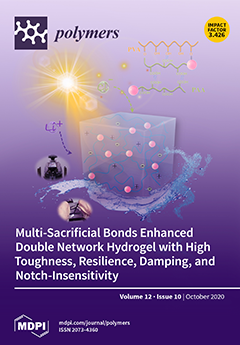Poly(ethylene) (PE) is a commonly used semi-crystalline polymer which, due to the lack of polar groups in the repeating unit, is not able to form Langmuir or Langmuir–Blodgett (LB) films. This problem can be solved using PEs with hydrophilic groups arranged at regular
[...] Read more.
Poly(ethylene) (PE) is a commonly used semi-crystalline polymer which, due to the lack of polar groups in the repeating unit, is not able to form Langmuir or Langmuir–Blodgett (LB) films. This problem can be solved using PEs with hydrophilic groups arranged at regular distances within the polymer backbone. With acyclic diene metathesis (ADMET) polymerization, a tool for precise addition of polar groups after a certain interval of methylene sequence is available. In this study, we demonstrate the formation of Langmuir/LB films from two different PEs with regular phosphoester groups, acting as crystallization defects in the main chain. After spreading the polymers from chloroform solution on the water surface of a Langmuir trough and solvent evaporation, the surface pressure is recorded during compression under isothermal condition. These
π-
A isotherms, surface pressure
π vs. mean area per repeat unit
A, show a plateau zone at surface pressures of
~ (6 to 8) mN/m, attributed to the formation of crystalline domains of the PEs as confirmed by Brewster angle and epifluorescence microscopy. PE with ethoxy phosphoester defects (Ethoxy-PPE) forms circular shape domains, whereas Methyl-PPE-
co-decadiene with methyl phosphoester defects and two different methylene sequences between the defects exhibits a film-like morphology. The domains/films are examined by atomic force microscopy after transferring them to a solid support. The thickness of the domains/films is found in the range from
~ (2.4 to 3.2) nm depending on the transfer pressure. A necessity of chain tilt in the crystalline domains is also confirmed. Grazing incidence X-ray scattering measurements in LB films show a single Bragg reflection at a scattering vector q
xy position of
~ 15.1 nm
−1 known from crystalline PE samples.
Full article






